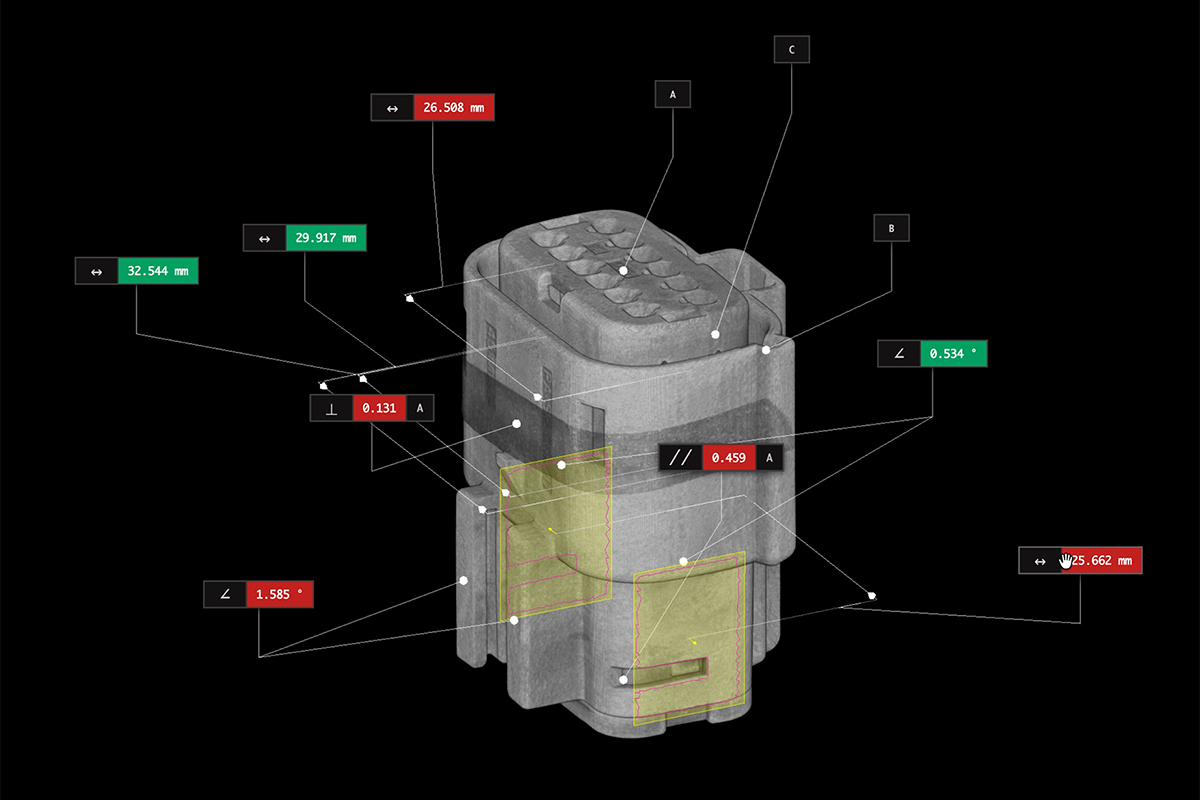Pen Comparison Using Industrial CT
Every time we reach for a pen and start writing, we trigger a surprisingly complex process of fluid dynamics that transfers ink from a reservoir onto paper. Even the most common pens—ballpoint, rollerball, felt tip, and fountain—represent the culmination of designs perfected over centuries to make something as mundane as writing a To-Do list possible.
Using our Microfocus Neptune industrial CT scanner, we knew we had the perfect tool to peer into the inner workings of these everyday objects. Let’s dive into the details of these three pen types and the precision engineering that keeps them flowing smoothly.
Majohn Retractable Fountain Pen
The fountain pen stands as a timeless symbol of writing elegance, with its roots stretching back to the 10th century. Its design may seem classic, but there’s more going on under the hood than you might expect. We wanted to scan a modern incarnation of this pen, so we opted for a Majohn (Moonman) A1 retractable fountain pen. At a price point of $40, the A1 provides an affordable alternative to Pilot’s premium ($168) Vanishing Point retractable fountain pen.
This design combines the convenience of a retractable pen body with the beauty of the classic fountain pen design. A spring-loaded mechanism shuts over and protects the nib when retracted, preventing the water-based ink from drying out.
The key to the fountain pen’s inkflow is capillary action—the process by which liquid flows through narrow spaces without help from external forces, driven by the liquid’s surface tension and the adhesive forces between the liquid and the solid surface. In the fountain pen, the slit in the nib acts as a narrow channel that exploits capillary action to draw ink from the reservoir to the tip, ensuring a steady flow as you write. In our Voyager software, we can measure the hair’s breadth tapering of the nib slit from the base to the tip. At the base, the slit measures 0.128 mm wide; at the tip, it narrows to only 0.016 mm.

Explore the scan
BIC Ballpoint Pen
Next up, we examined a writing implement that has probably been in your hand countless times—the ballpoint pen. The ballpoint pen was invented in the 1930s and hit the market in the 40s, but it didn’t really became popular until the 60s when disposable pens were created.
Ballpoint pens revolutionized writing by using oil-based ink that dries quickly, avoiding smudges. But the real magic lies in the precision engineering of the ball tip. In our CT scan, you can see how a tungsten carbide ball is housed within a brass enclosure. Because of its elemental composition, the ball attentuates X-rays much more than the brass. We also see the five claw-like channels that guide ink toward the ball, allowing for the effortless writing we often take for granted.
Take this cross-sectioned 3D model of the pen for a spin below in our Voyager window.
The assembly process behind this pen is remarkable: the ball is inserted into the housing through the tip, and then the entire assembly is crimped with pinpoint accuracy. With tolerances as tight as 100 nanometers, it’s no wonder ballpoint pens became the go-to writing instrument worldwide.
Pilot Rollerball Pen
Next up, the rollerball pen brings together the best of both worlds: the precision of a ballpoint and the smooth ink flow of a fountain pen. First introduced in the 1960s, rollerball pens use water-based ink, which gives them a fluid writing experience with minimal pressure. But this design isn’t without its trade-offs—rollerball pens tend to run out of ink faster and are more prone to bleeding through paper.
In our scan, you can see how the ball is dropped into the stainless steel housing tube and crimped from three directions, holding it in place. Rollerballs depend on gravity rather than capillary action to deliver ink to the tip from the reservoir in the pen body.

Explore the scan
Paper Mate Felt Tip Pen
Felt tip pens, introduced in the 1960s, offer a unique writing experience by using a porous, absorbent material instead of a ball or nib to transfer ink. Unlike the ballpoint or rollerball pens that rely on machined metal components, felt tip pens use a fibrous tip to regulate ink flow.
We recently helped The New York Times Wirecutter investigate why Ralph Nader’s beloved felt tip pens seem to be running out of ink faster than before. We scanned Paper Mate Flair pens from 1966 up to the present and found that it has undergone notable design changes over the decades. Originally, the Flair featured a larger, fully felt tip that allowed for expressive, bold lines. In the late 1970s and 80s, a white plastic point guard was added to protect the tip.

Explore the scans
In our Microfocus CT scans of all the pen models, you see how the ink is wicked through the felt material to the writing tip. We can even characterize the fiber orientation and ink saturation. This comparison shows that, despite simpler mechanics, felt tip pens still rely on controlled fluid dynamics—just like their ballpoint and fountain counterparts.
More Than Meets the Eye
From the precision of the ballpoint pen to the timeless elegance of the fountain pen and the smooth flow of the rollerball, each design solves the same problem—how to deliver ink efficiently—but with its own unique engineering approach. With industrial CT, we can fully grasp the craftsmanship that goes into creating even these everyday wonders.
If you’re curious to delve deeper into how the world around you is made, make sure to explore more of our content and discover other industrial CT applications. Stay tuned for more deep dives into the hidden worlds of product design and manufacturing.










